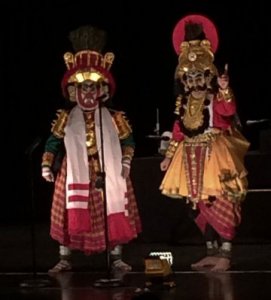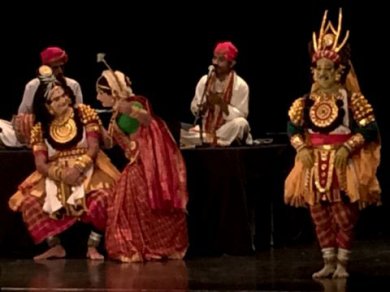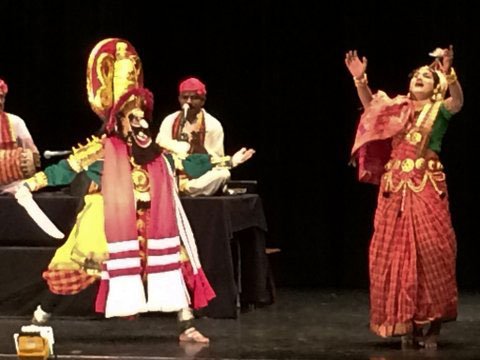
|   |

|   |
Fascinating 'Seethaapaharana' in San Francisco Bay Area Text & pics: Poornima Ramaprasad e-mail: poornima@sbcglobal.net May 14, 2016 The divinity of Ramayana is so eternal that it is a tireless and fresh experience even when you watch it for the 100th time, add a few more zeroes, it does not matter. And when the Yakshas tell the story in a colloquial style with enchanting music, dance, drama, costumes, makeup and much more, imagine how good life can get. Such was the experience when Idagunji Mahaganapathi Yakshagana Mandali of Uttara Kannada District of Karnataka performed the "Seethaapaharana" episode of Ramayana. The event was arranged by Kannada Koota of North California and Bay Area Havyaka Sangha on April 30, at the Santa Clara High School auditorium in Santa Clara, California. The troupe performed to a packed crowd of about 400 spellbound rasikas.   The narrative started with Shurpanakha going to her mighty brother Ravana’s court after being insulted by the brothers Rama and Lakshmana in Panchavati. Shurpanakha entices Ravana with Seetha’s beauty and that she would make a great pair with him. Ravana, who had once lost Seetha to Rama in the swayamvara, thinks he has got a second chance now and is bent upon abducting Seetha and making her his own. He calls his uncle Maricha to help him in his evil endeavor. Maricha tries hard in vain to convince Ravana against this. He remembers that he had escaped Rama’s wrath when he had disturbed Vishwamitra’s yagna and resolves that he would die regardless for if he did help Ravana, he would die at Rama’s hands, if not, he would die at Ravana’s. Maricha takes on the mayaa jinke (magical golden deer) form per Ravana’s orders and goes playfully near Rama’s ashrama and attracts Seetha. Seetha is so attracted, despite Rama's warning that it does not look real and must be some Rakshasa trick. She begs Rama to go and get it for her. Rama succumbs to her request and tells Lakshmana to take care of her as he heads to pursue the deer. When Rama shoots the deer, the demon Maricha calls upon Seetha and Lakshmana in Rama’s voice and gives up his life. A worried Seetha now forces Lakshmana to go to Rama’s help, which he has to do much against his will after giving her warnings not to cross the Lakshmana Rekha that he draws around her with his magical protective prowess. Upon his departure, Ravana arrives as a sage begging for alms and tricks Seetha into crossing the Lakshmana Rekha and carries her away with him. Jatayu, the vulture-king, tries to protect Seetha but Ravana chops off his wings making Jatayu immobile as he flees. It was very interesting to observe many aspects of Natya Shastra followed to the tee. The opening scene was introduced from behind a hand-held curtain carried by two stage artists. The characters then dramatically become visible to the audience with an obvious introduction along with the time and situation of the play. The musicians were given half the center stage (Ranga Shirsha) and were not in the side wings. The front half of the stage (Ranga Pitha) was used for the drama. The slain Maricha crawls out in pain not showing death on stage. Stage setup was simple and props almost none. Another important story aspect to observe in this presentation was that despite being in exile and living an ascetic life, Seetha was clad in jewellery and looked like a queen. This is justified by a story line that says on the day of ‘Apaharana’ (abduction), Rama had incidentally asked Seetha to wear the ornaments that were given to her by Sati Anusuya and that she was indeed decked beautifully. And this also gives a logical explanation as to how Rama found Seetha’s ornaments to find his way to her. The minimalistic live music was a treat. All the moods were exaggerated by apt ragas. Happiness, playfulness, romance between Rama and Seeta were shown by ragas Kambhoji, Kalyani, Aarabhi, Hindola. The compassion and sadness were shown with Purvikalyani, Thodi, Revathi. Ragas like Shivaranjani, Sindhubhairavi were used for a mass appeal. Song lyrics were as simple as a musical dialogue. The actors displayed deft footwork and crafty Yakshagana moves that mesmerized the audience. Each character had solo jathis, which were very impressively played by maddale and chande drums though there was no vocal nattuvangam rendition. 

The colloquial style of dialogue rendering made it easily understandable to audience of all levels, young and old. The way Ravana, disguised as a sage, changes to become Ravana, the demon king, was phenomenal. The typical family jokes with which the characters improvised the narrative were amusing. The audience went into roars of laughter when Rama teases Seetha with mundane man-woman jokes in an apt way. Traditionally Yakshagana, which is a folk art of coastal Karnataka, was played overnight as an entertainment, as a way to educate people about culture and day-to-day affairs including political and social issues by means of improvising upon the script in a tasteful way. Direction and choreography by Keremane Shivananda Hegde was brilliant. He belongs to the illustrious Keremane family which established the Idagunji Mahaganapathi Yakshagana Mandali 84 years back and has the distinction of starting the tradition of ‘Kalamithi Yakshagana’ meaning scripting the stories to a given time. Bhagavatharu Ananth Hegde did a fantastic job on the vocals. Maddale by Parameshwara Hegde and chande by Prasanna Bhat were delightful. Costumes of Jatayu, Maya-jinke, Shurpanakha, Ravana excelled every imagination. All the artists gave their best making it a grand experience for the audience and leaving them wanting more. What else to say, “There are those who make life good for others.” Definitely, on behalf of everyone who watched, I can say, the evening was bliss. Poornima Ramaprasad follows Indian classical music and dance forms. She reviews Indian dance and drama events in the San Francisco Bay area from time to time. |